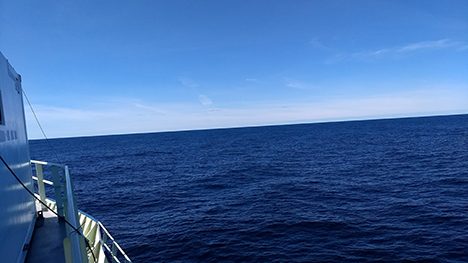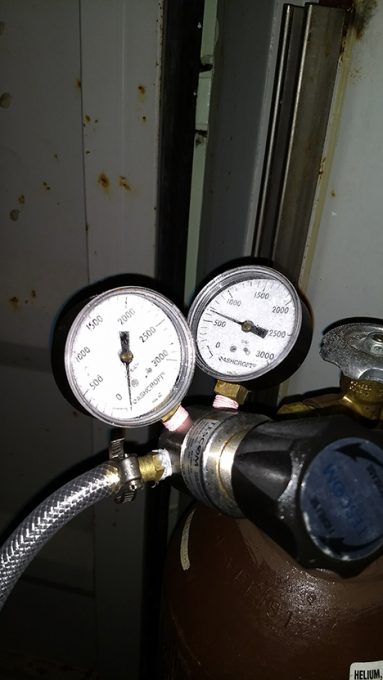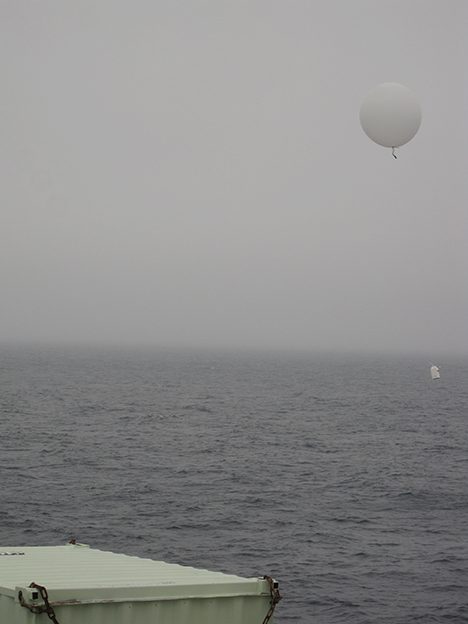Near Oceans End
This cruise is all but over and at this time tomorrow I will be several beers deep in the aftermath of the end of cruise party.
Meantime I promised that sweet heart, Kristina, that I would write a BLOG … so here you go sister :).
There is something about standing on and ocean-going ship. Sure footed for the moment. Gaze cast on an endless horizon of deep blue water against a pale blue cloud feathered sky. That gives me full focus on the enormity of our planetary home and life support system. All life that we know about is here. Full stop…

Starboard view on board the R/V Atlantis
Such clarifying moments buffer me against a dry land back drop of emotionally charged “discussions” of climate and resources.
It re-invigorates my drive to do my part in the difficult job of characterizing this planets vital composition.
I take ever increasing pride in my role as technical support for these missions. I truly love being able to help the dedicated scientists who choose to become involved in this massive undertaking. They are Heroes, all of them. I challenge you to have your own clarifying moment and become an earth scientist if you can.
On this cruise, whilst sorting through the latest problem with the instruments, I was able to help with weather balloon launching.
In its basic form this consisted of tying opposite ends of a string to a helium filled balloon and an electronic measuring instrument and hurling it at the sky. The electronic measuring instrument radios back to the ship what it measures for temperature, humidity and pressure along with its GPS location.
A technical term for this is Atmospheric vertical profiling and scientists use this data to help them interpret other measurements in the atmosphere. For example, they measure gas concentration on board our companion C130 Aircraft. The temperature, relative humidity and wind direction measured by the balloon electronics at different altitudes give clues to the source of the gas that they are measuring.
Here is an example of a plot generated by the balloon data.

Screen shot of balloon profile of atmospheric data.
Measurements package itself resembles a cardboard takeout carton … with a hobby kit microcomputer inside and an antenna for a tail. The string like a twine roll for flying a kite with a rubber spinny thing to … well I never quite figured that bit out but it think it controls the payout rate of the string.

Rope spool for radiosonde balloon
The helium tank … a Mickey Mouse hot dog?

Helium tank used to fill radiosonde balloons
And the balloon … aaah well a big floppy piece of rubber… nuf said.
In addition to being useful scientifically launching these things can be challenging and fun.
If you can imagine escorting a three foot balloon madly trying to escape your grasp while flapping in 20 mile per hour winds wanting to impale itself on every pointy bit on the deck or wrap around the ship railing. Lofting it in the air only to have it flail away or come back at you and bounce off various parts of you , the ship or the water. Let’s just say each launch had its own interesting characteristic.
When the wind comes from behind the ship fast enough the balloon races ahead of the ship.
Sometimes the balloon goes horizontally for a while and then decides to deposit the sensor package unceremoniously into the ocean. In the dark, with rain and the ship bouncing at 12 knots …well you get the idea.
Here are a few of the balloon destruction surfaces .

A frame balloon target (left) and an antenna balloon target (right).
For the most part the launches are successful and a welcomed break rom other shipboard tasks.

Floating radiosonde balloon after a successful launch on board the R/V Atlantis.
All good fun … but for now. A parting verse.
We are waiting to dock in with the morning high tide
Thanks to the ship’s crew for a wonderful ride
Hoping to see you all with will to defend
And instruments in hand, at the near oceans end.
Cheers,
Cyril McCormick



